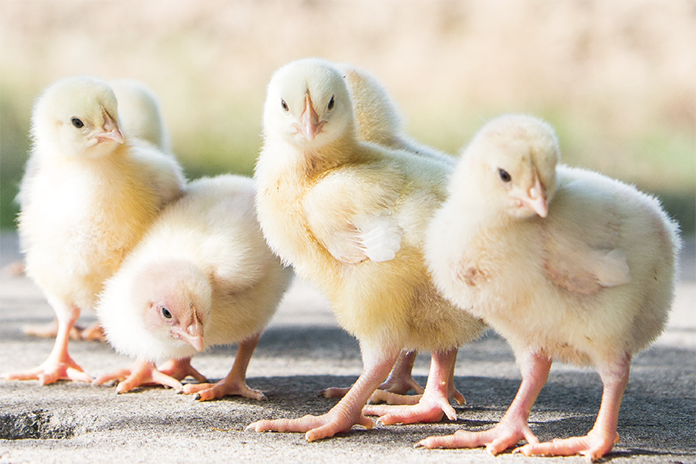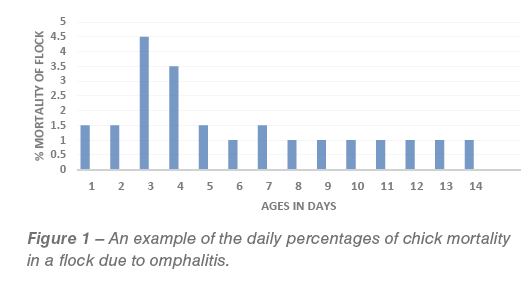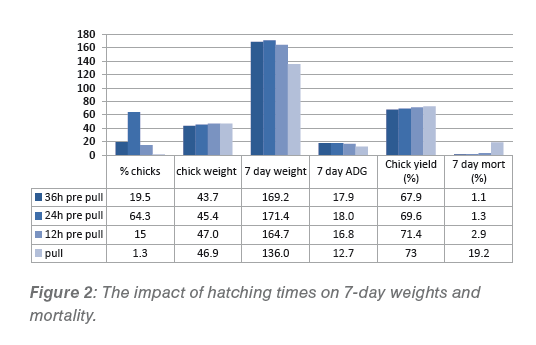
When asking the question “What is good chick quality?”, the responses can be very different based on the person and their role. For instance, the hatchery manager would like to see maximum grade A chicks and good clean navel quality. The broiler farm manager wants to see well-hydrated, active chicks and low mortality levels, whereas the veterinarian wants to see good active chicks, well-healed and infection free navels. The sexer wants late hatching chicks because they are easier to sex. Several measurement systems have been promoted in the literature to relate chick quality characterisitics to growth and performance potential.
- Visual scoring systems relating to chick defects. This method is highly subjective and although rapid and practiced in many hatcheries is a poor predictor of early chick mortality.
- Chick weight as an indicator of 7-day weight and as a correlation to final weight. Although research indicates 7-day weight is a fair predictor of final broiler harvest weight, there is no agreement among research reports on using day-old chick weight to predict 7-day weight.
- The Pasgar system evaluates reflex, navel closure, legs, beak and residual yolk abnormalities. These chick characterisitics appear to be reliable indictors of early chick mortality, but have not been proven useful for broiler performance predictions.
- Measurements of chick length along with evaluating residual yolk and navel closure. This system promotes the evaluation of the residual yolk and navel region from a random sample of 50 chicks. These factors are correlated with coli infection risk. Chick length was also evaluated because it has a high correlation with broiler performance. In this way, early chick mortality and broiler performance can both be predicted.
 Over the years, the poultry industry has tried to correlate incubation protocols or chick quality characteristics (navel quality, red hocks, feathering, bright eyes and tall, up- right chicks) to 7-day mortality levels. In practice, most hatcheries have not been successful in relating these measurements to first week mortalities.
Over the years, the poultry industry has tried to correlate incubation protocols or chick quality characteristics (navel quality, red hocks, feathering, bright eyes and tall, up- right chicks) to 7-day mortality levels. In practice, most hatcheries have not been successful in relating these measurements to first week mortalities.
An example of an early chick mortality pattern caused by omphalitis (yolk sac infection) is shown in Figure 1. This infection is challenging because it cannot be detected at the hatchery with visual inspection. In fact, chicks appear to be of good quality upon arrival at the farm.

The question at the hatchery still remains, “how can we predict 7-day mortality of hatching chicks?”
To address this question, a series of hatch window trials were conducted at Cobb to evaluate the effects of hatching times on 7-day early mortality. In each trial we recorded the number of chicks hatched at 12 hour intervals. At each time interval we separated the hatched chicks from the eggs that had not hatched but kept them in the hatcher until hatch pull. We weighed the groups of chicks and marked them separately at the broiler farm to record the 7-day weights and mortality levels.
Our data revealed the lowest mortality and highest 7-day weights were in the groups of chicks that hatched early in the hatch window (24 to 36 hours). Moreover, these groups had the lowest chick yield % (chick weight as a percentage of initial egg weight).
First of all, it is important to note that you cannot hatch all the chicks at the same time and it is normal to see a hatch window of 24 to 30 hours from first chick to last chick. Hatch time among eggs varies but is largely dependent on the rate of embryo development where higher incubation temperatures increase metabolism and promote increased embryonic development and lower temperatures reduce metabolism and delay embryonic development. For optimal hatch and chick quality, it is critical to maintain a uniform temperature and humidity across the incubator.

Therefore, we asked, does hatch time influence first week mortality numbers?
Since hatch time is related to incubation temperature, we used three different temperature profiles to incubate eggs and measured the impact of these temperatures on 7-day mortality, chick yield and 7-day body weights. All the eggs were kept at eggshell temperatures of 100.0 °F for the first 10 days of incubation. After 10 days of incubation, eggs were split into 3 groups and incubated at one of 3 temperatures: 98.5 °F (low), 100.0 °F (normal) or 101.5 °F (high), and maintained at this temperature until transfer to the hatchers. All 3 groups were kept separate in 3 individual setters (4,800 eggs each) and all eggs had the same source flock to minimize variables associated with flock or breeder age.
As shown in Figure 3, high incubation temperatures resulted increased 7-day mortality and decreased body weights relative to normal incubation temperatures. At high incubation temperatures, chick yield was about 65% indicating too much egg weight loss and most likely resulted in dehydrated chicks (Photos 1 and 2). In this case, dehydration impacted weight gain and mortality.

In the group of eggs incubated at low temperature (98.5 °F), the 7-day weight is the lowest and 7-day mortality is the highest. The chick yield percentage is also the highest in this group.
It appears that the low incubation temperature reduced metabolic rate and / or delayed development resulting in less absorption of the egg yolk sac. The high 7-day mortality may have been the result of infection susceptibility interacting with environmental stressors.
There are a variety of stressors that can impact newly hatched chicks before farm delivery.  For example, temperatures too high in the hatcher, chilling or overheating in the chick processing, holding areas and transport or at the farm can elevate stress and the opportunity for infections. Symptoms of typical stress factors include seeing chicks ‘panting’ in boxes, ‘flat’ due to lack of ventilation / oxygen or ‘huddling’ (Photos 3 and 4). Other stresses, however, including cold draughts directed onto chicks either by fans in holding or wind blowing directly into the back of the truck can also slow weight gain and make chicks more susceptible to infection. Cloacal temperature can be used to evaluate chick condition.
For example, temperatures too high in the hatcher, chilling or overheating in the chick processing, holding areas and transport or at the farm can elevate stress and the opportunity for infections. Symptoms of typical stress factors include seeing chicks ‘panting’ in boxes, ‘flat’ due to lack of ventilation / oxygen or ‘huddling’ (Photos 3 and 4). Other stresses, however, including cold draughts directed onto chicks either by fans in holding or wind blowing directly into the back of the truck can also slow weight gain and make chicks more susceptible to infection. Cloacal temperature can be used to evaluate chick condition.  Normal cloacal temperature should be between 40.0 °C – 40.6 °C for the first day. At 41.0 °C, chicks will start ‘panting’ which is an indication of heat related stress.
Normal cloacal temperature should be between 40.0 °C – 40.6 °C for the first day. At 41.0 °C, chicks will start ‘panting’ which is an indication of heat related stress.
To reduce 7-day mortality, hatchery managers should focus on chick yield % and minimizing stress factors. The normal ‘rule of thumb’ is that a day-old chick should weigh two-thirds or 67% of the initial egg weight. To achieve this egg weight loss in the setter should be 11-13% by transfer. Chick yield percent is measured from the average weights of eggs and chicks obtained from individual flock sources, and is not focused on individual egg and chick weights.
 The hatchery manager should be aware as to the amount of time a chick will be in transport and adjust incubation profile accordingly. The hatchery manager should achieve a chick yield % between 66 and 88 for short distance chick placements. For long distance placements, achieve a chick yield % between 68-70. The higher percentage chick yield will allow chick weight loss during transit while still arriving at the farm with the chick yield % close to the normal target of 66-68.
The hatchery manager should be aware as to the amount of time a chick will be in transport and adjust incubation profile accordingly. The hatchery manager should achieve a chick yield % between 66 and 88 for short distance chick placements. For long distance placements, achieve a chick yield % between 68-70. The higher percentage chick yield will allow chick weight loss during transit while still arriving at the farm with the chick yield % close to the normal target of 66-68.
Conclusion
In summary, the key points to chick quality are:
- Adapt incubation profiles to achieve a setter weight loss of 11-13% by 18 days of incubation. Young flocks will have lower weight loss and older flocks
- Achieve a chick yield % between 66-68 for short distance chick deliveries and 68-70 for long distance deliveries.
- Eliminate stress factors after the chicks have hatched i.e. overheating or lack of ventilation in the hatcher, environmental conditions in the chick processing, holding areas, in transit and at arrival at the farm.
- Avoid overheating as is common with insufficient ventilation or chick boxes placed too close together with little air circulation.
- Avoid cold draughts that may be caused by holding room fans blowing onto
- Park delivery truck facing the prevailing winds so the chicks are not exposed during
- Cloaca temperatures – should be maintained between 40.0 °C – 6 °C at all times in the first day for chicks to maintain their comfort zone. At 41.0 °C, chicks will start ‘panting’ which is an indication of heat related stress.

















